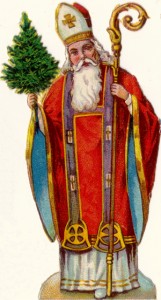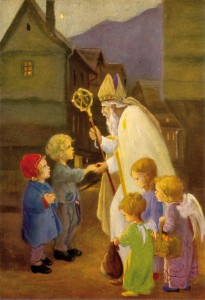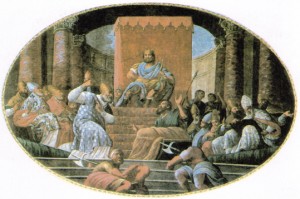The truth about Old Saint Nick : Why Turkey means more than Christmas dinner
by Jim Chliboyko
“East of Marmaris the coast loses most of its wrinkles and the Greek Islands are left behind,” reads the dog-eared copy of Lonely Planet’s West Asia on a Shoestring. “The coast is sprinkled with ruins… and it’s studded with beautiful beaches and washed by clear water ideal for scuba diving,” says the book, referring an area known as the Turquoise Coast, or the Turkish Riviera.
Further on, the book refers to another area around a small town now called Demre: “There are vast river deltas covered in greenhouses and citrus groves—Turkey’s Florida.”
Given this time of year, you may think the Turquoise Coast may sound like a nice vacation destination, or a place from which your backpacking children might call you one day. But if the unsuspecting traveller stumbles into a particular ancient church in Demre, and if that traveller hasn’t boned up on saints or fourth century history, there may be a surprise waiting: Demre is where Santa Claus called home. Father Christmas was Turkish.
More properly, the man on whom Santa Claus was originally based, St. Nicholas, was a resident of Asia Minor, a Christian from an essentially Greek neighbourhood of the Roman Empire. But he was born, raised and lived his life in a small area in the present-day state of Antalya, in today’s Turkey.
One of Nicholas’ somewhat lesser-known titles was Bishop of Myra, a bit of a dour-sounding occupation for a man years later referred to as a “jolly, old elf.” In fact, much of what has been written about him, a lot of it more legend than truth, runs counter to the happy, benign, rather secular symbol of the holidays.
“There are people in that epoch that we know a lot about; he’s not one of them,” says Rev. Dr. John Stephenson, an associate professor of Historical Theology at St. Catharines’ Concordia Lutheran Theological Seminary.
“I’d say two things: first of all, we know that there is a figure of St. Nicholas of Myra. We know he was a bishop and where he was a bishop. And he lived at a time when persecution of Christians was still raging.”
Whatever you call him, St. Nicholas is, considering his current manifestation, a strangely shadowy figure. He is thought to have been born to well-off parents in the town of Patara, and at some point in his young life, whether as a child or young adult, it is believed he was orphaned. This may have led to a sudden turn deeper into Christianity, a brave pursuit in a region more influenced by the Hellenistic culture.
Persecution
As Nicholas’ life is thought to have lasted from about 270 AD to 345 (or so), he would have had to withstand the Roman Emperor Diocletian’s Great Persecution of the Christians or, rather the persecution started by Diocletian, and enforced and supported by Galerius. This would be the signal chapter of Nicholas’ life, occurring just as he began his career as Bishop of Myra.
“We can make an informed guess that he became a priest while in his early twenties,” writes D.L. Cann in Saint Nicholas, Bishop of Myra. “And served as a priest for a few years in Patara before he moved to Myra.”
Cann speculates that Nicholas became Bishop of Myra, a couple of days’ journey away from Patara, at about the age of thirty. Though the phrase “under the radar” was still 1600 years away, this is what Cann speculates led to Nicholas’ promotion; Myra was merely a provincial capital and Nicholas the priest was hard-working and devout. And the position was vacant: the local bishop apparently had just died.
At the time, however, not just Myra, but the whole eastern half of the Roman Empire was suffering under the Emperor Diocletian’s active persecution of Christians. Cann speculates Nicholas was imprisoned shortly after receiving his promotion.
If we don’t know a lot about Nicholas’ life, less is known of his imprisonment. When the Italian basilica in Bari, where Nicholas’ bones are placed, underwent restoration in 1953, a professor from a nearby university received permission from the Vatican to examine Nicholas’ intact bones. Among some of the interesting findings—Nicholas stood at about five feet tall—was that he had suffered a broken nose. While historical speculation is a dangerous business, the break is evidence of either an accident or violence. “That could have been from the beatings he received (in imprisonment),” offers Prof. Stephenson.
To understand what events unfolded to free Nicholas, one should either have a degree in Roman history or be well-versed in Edward Gibbon’s The History of The Decline and Fall of the Roman Empire. Emperor Constantine eventually ended Nicholas’ (and the others’) beatings. The emperor, whose profile rose through various infighting Romans (another story in itself) was sympathetic toward the Christians and even decorated his armies’ banners with ‘chi’ and ‘rho,’ the first two Greek letters of Christ’s name.
Over the decade-long persecution, the Roman high command went through many changes. There was a great deal of infighting, and the man the Christians needed to rise was the one who persevered. When the anti-Christian autocrat Diocletian relinquished his command, Galerius took over but later died, as did Maximinus. The remaining pretender to the Roman throne, Licinius, was eventually subdued (though he remained restless) by Constantine.
Also known as Constantine the Great, and the man after whom Constantinople (Istanbul) was named, Constantine and Licinius jointly signed the Edict of Milan in 313AD, which freed the Christians from their decade of oppression (as well as returning their confiscated property and restoring the status of Christianity).
But after the ten years of oppression, Nicholas would have no time to rest and enjoy the sudden peace and acceptance his faith. This is when one of the great stories of Nicholas’ leadership appears, around the year 313. The area around Myra was devastated from the persecution, the countryside had been effectively emptied of farmers. “The working farms that remained after the wars had not produced enough food to prevent famine in the province of Lycia,” writes Cann.
Cargo ships often stopped at Myra on their way from Egypt to Constantinople. One of the great legends of Nicholas is that he commandeered some ships on their way to the emperor’s capital and talked the captains into leaving enough grain behind to feed (and seed the grounds of) the citizens of his diocese for two years.
The legend is that, at the Council of Nicaea, St. Nicholas boxed Arius’s ears
The creed council
Nicholas, however, also had a hand in something with which regular churchgoers will be more than familiar. “It’s likely, not certain, that (Nicholas) was one of the bishops at the Council of Nicea,” says Prof. Stephenson, of the grand meeting that created the Nicene Creed.
A dozen years after being freed, debate was raging within the Christian community about the nature of Christ, largely provoked by Arius, a Christian priest serving in Egypt who put forward the idea that, according to Webster’s Dictionary, “Jesus was not of the same substance as God, but a created being exalted above all other creatures.” This controversy angered Constantine, who was moved to call for the Council of Nicaea in 325, in an effort to unify the church in its first ecumenical council. There are theories that Nicholas was there, in a show of support for the anti-Arian side. Some say it was a physical show of support.
“The legend is that St. Nicholas boxed Arius’s ears,” says Prof. Stephenson. “It’s a nice touch.”
There are other nice touches in the story of Nicholas of Myra. The more famous include saving sailors from storms raging near his home port and saving three soldiers from an unlawful execution which was about to take place because of a bribe. And in yet a grimmer, even more shadowy legend, Nicholas not only solves the murder of three children (also referred to as three students), but he raises them from the dead.
“The stories show that Nicholas was about much more than sentimental gift-giving to loved ones,” says Carol Myers, who helps run the St. Nicholas Center in Holland, Michigan, an organization devoted to promoting the figure of St. Nicholas. “His whole life was lived as a faithful disciple of Jesus Christ.”
Generosity
 The legend most closely related to gift giving, though, involves a poor Pataran family which had three daughters. There was no money for a dowry for the girls, so they were on the verge of being sold into either slavery or prostitution, depending on the source. According to the book 100 Saints, “This came to the ears of Nicholas, who thereupon took a bag of gold and, under cover of darkness, threw it in the open window of the man’s house… At intervals Nicholas did the same for the second and third (daughters).” The father eventually caught Nicholas in the act.
The legend most closely related to gift giving, though, involves a poor Pataran family which had three daughters. There was no money for a dowry for the girls, so they were on the verge of being sold into either slavery or prostitution, depending on the source. According to the book 100 Saints, “This came to the ears of Nicholas, who thereupon took a bag of gold and, under cover of darkness, threw it in the open window of the man’s house… At intervals Nicholas did the same for the second and third (daughters).” The father eventually caught Nicholas in the act.
Nicholas died in the mid-fourth century, one of the few saints to die of natural causes. An Italian party stole his intact bones from Myra in the 10th century, shipped them back to Italy and placed them in Bari’s Basilica di San Nicola.
Since his death, people all over the world have contributed to the perception and interpretation of Nicholas. Even a prominent German priest got into the act. “Martin Luther substituted the Christ child for St. Nicholas as a bearer of gifts and moved the day of his arrival from December 6 to Christmas as part of an effort to remove the last vestiges of paganism from the Christian church,” according to the editors of Holiday Symbols.
Within the last few generations a variety of writers and illustrators have played with the appearance and the notion of St. Nicholas, including American writers Clement Moore (A Visit from Saint Nicholas) and Washington Irving (A History of New York), with every slightly different version gradually leading to the “jolly, old elf” we have today.
In current day Myra/Demre, the town’s mayor erected a gaudy plastic statue of Santa Claus in 2005 in front of St. Nicholas’ actual church, to the mortification of visiting Russian tourists for whom Nicholas is still a prominent figure. And the bones of the tough, beaten bishop and ex-con, the patron saint of Greece, Russia, the island of Sicily, as well as bakers, brides, merchants, apothecaries, children, pawnbrokers, prisoners and sailors, remain in Bari, Italy. Yet, the tales of Nicholas’ bravery and faith, despite the modern depiction of the man who was the saint, still inspire.
“As a priest and bishop, Nicholas put Jesus Christ at the centre of his life and ministry,” says Carol Myers. “His concern for children and others in need or danger expressed a love for God which points toward Jesus, the source of true caring and compassion.”
“Jesus is the reason for the season; Nicholas is the historical figure that backs this up,” says Prof. Stephenson. “He’s not just Father Christmas that has gifts on his back. He’s not just nice for the sake of being nice.”
For more information on Saint Nicholas of Myra visit www.stnicholascenter.org
Jim Chliboyko is a freelance writer in Winnipeg.






